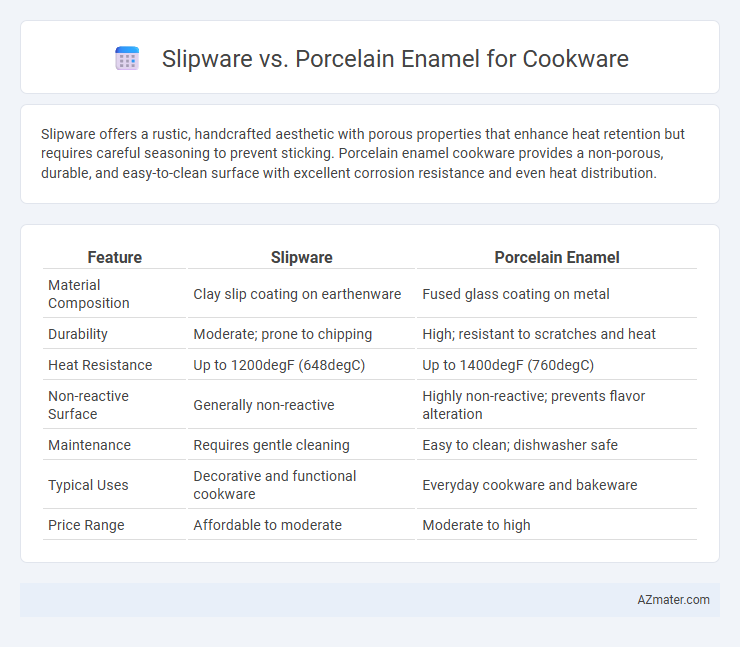Slipware offers a rustic, handcrafted aesthetic with porous properties that enhance heat retention but requires careful seasoning to prevent sticking. Porcelain enamel cookware provides a non-porous, durable, and easy-to-clean surface with excellent corrosion resistance and even heat distribution.
Table of Comparison
| Feature | Slipware | Porcelain Enamel |
|---|---|---|
| Material Composition | Clay slip coating on earthenware | Fused glass coating on metal |
| Durability | Moderate; prone to chipping | High; resistant to scratches and heat |
| Heat Resistance | Up to 1200degF (648degC) | Up to 1400degF (760degC) |
| Non-reactive Surface | Generally non-reactive | Highly non-reactive; prevents flavor alteration |
| Maintenance | Requires gentle cleaning | Easy to clean; dishwasher safe |
| Typical Uses | Decorative and functional cookware | Everyday cookware and bakeware |
| Price Range | Affordable to moderate | Moderate to high |
Introduction to Slipware and Porcelain Enamel Cookware
Slipware cookware features a traditional pottery technique using a liquid clay slip applied for decorative and functional purposes, often characterized by its rustic, handcrafted appearance and porous nature that requires careful seasoning. Porcelain enamel cookware consists of metal, usually cast iron or steel, coated with a smooth, durable layer of glass fused at high temperatures, offering non-reactive, easy-to-clean surfaces ideal for heat retention and even cooking. The choice between slipware and porcelain enamel depends on preferences for aesthetic appeal, durability, and maintenance needs in kitchen cookware.
Historical Background of Slipware and Porcelain Enamel
Slipware, originating in ancient civilizations such as Mesopotamia around 3000 BCE, involves decorating pottery with liquid clay slip, a technique widely used in European and Asian cultures for centuries due to its durability and decorative potential. Porcelain enamel, developed in the early 19th century, combines powdered glass fused to metal at high temperatures, offering a durable, non-reactive, and heat-resistant surface for cookware, popularized during the Industrial Revolution in Europe. Both materials reflect distinct technological advancements and aesthetic preferences in cookware history, with slipware emphasizing artisanal ceramic traditions and porcelain enamel embodying industrial innovation.
Material Composition and Production Processes
Slipware cookware is crafted by applying a liquid clay slip over a fired ceramic base, creating a porous, absorbent surface that requires careful glazing to prevent moisture penetration. Porcelain enamel cookware involves coating metal, typically cast iron or steel, with a durable layer of powdered glass fused at high temperatures, resulting in a non-porous and highly resistant surface. The slipware process emphasizes ceramic techniques and intricate glazing, while porcelain enamel production combines metal fabrication with vitrified enamel application for enhanced durability and heat retention.
Durability and Longevity Comparison
Slipware cookware, made from earthenware clay, offers moderate durability but is prone to chipping and cracking under heavy use, reducing its overall lifespan. Porcelain enamel cookware features a metal core coated with a vitreous enamel layer, providing superior resistance to scratches, stains, and thermal shock, significantly enhancing durability. The non-porous surface of porcelain enamel prevents corrosion and maintains structural integrity over time, resulting in longer-lasting performance compared to slipware.
Heat Conductivity and Cooking Performance
Slipware cookware, typically made from earthenware clay, offers moderate heat conductivity but heats unevenly compared to porcelain enamel. Porcelain enamel, applied over cast iron or steel, provides excellent heat retention and more even heat distribution, enhancing cooking performance and minimizing hot spots. The non-porous, smooth surface of porcelain enamel also supports better food release and easier cleaning, making it superior for precise temperature control.
Safety and Health Considerations
Slipware cookware, made from low-fired pottery with a slip coating, may be more porous and prone to chipping, potentially harboring bacteria and releasing harmful substances if the glaze contains lead or cadmium. Porcelain enamel cookware features a glass-like coating fused to metal at high temperatures, offering a non-porous, chemically inert surface that resists scratches and prevents metal leaching, making it safer for health. For durability and food safety, porcelain enamel is generally preferred over slipware due to its resistance to staining, corrosion, and contamination.
Maintenance and Cleaning Requirements
Slipware cookware requires gentle hand washing with mild detergents to preserve its hand-applied slip decoration and porous surface, avoiding abrasive scrubbers that can damage the finish. Porcelain enamel cookware offers superior stain resistance and non-porous surfaces, allowing easier cleaning often with just warm soapy water or a soft sponge, resisting rust and corrosion. Regular maintenance of slipware includes periodic seasoning or sealing treatments, whereas porcelain enamel demands minimal upkeep, maintaining its glossy, chip-resistant coating with simple cleaning routines.
Aesthetic Appeal and Design Options
Slipware cookware features hand-applied, earthy glazes that create unique, rustic patterns, offering a warm and artisanal aesthetic perfect for traditional or farmhouse kitchens. Porcelain enamel cookware boasts a smooth, glossy finish available in a broad spectrum of vibrant colors and sleek designs, making it ideal for modern and stylish kitchen decor. The design versatility of porcelain enamel allows for customizable motifs and contemporary shapes, while slipware emphasizes individual craftsmanship with each piece showcasing subtle glaze variations.
Cost and Value for Money
Slipware cookware generally offers a lower upfront cost compared to porcelain enamel, making it an attractive option for budget-conscious buyers seeking rustic charm and artisanal quality. Porcelain enamel cookware, while more expensive, provides superior durability, non-reactive surfaces, and long-term resistance to chipping and staining, delivering greater value for money over extended use. Investing in porcelain enamel may result in fewer replacements and enhanced cooking performance, justifying the higher initial expenditure for many home chefs.
Choosing the Right Cookware: Slipware vs Porcelain Enamel
Slipware cookware offers a rustic, handcrafted aesthetic with excellent heat retention and natural, non-toxic properties, ideal for slow cooking and simmering. Porcelain enamel cookware provides a durable, non-porous surface that resists stains and scratches, making it easier to clean and suitable for high-heat cooking. Choosing between slipware and porcelain enamel depends on your cooking style preference, durability needs, and maintenance willingness.

Infographic: Slipware vs Porcelain enamel for Cookware
 azmater.com
azmater.com